Photographing 'Slow and Low'
Documentary and photography series
This is a project about lowriding in California.
'Slow and Low' is a documentary about two men's experiences in the lowriding community. 'Photographing 'Slow and Low'' is a series of photos that give a glimpse into their lives and some of the people who surround them.
Daniel Galvez, professionally known as Danny D, has been lowriding and building lowriders since he was a kid. He is known worldwide for his elaborate paint and pinstriping. His employee, Stefanie Lizet Murga, is at the start of her career, and already one of a few women making waves in the industry.
Carlos Rodriguez began lowriding in his adulthood and is part of the backbone of Sacramento's cruise nights. The community turns out and boldly represents their respective car clubs but all are supportive of one another. It's not unusual to see a group cruise by with a different club's plaque in each window.
This documentary and photography series is a look into lowriding's past, with profiles and voices of lowriders and custom painters, and touches on the factions of lowriding.
Alas, lowriding is not strictly a boys' club, but this project does focus on two men in the community.
Slow and Low: Lowriding and customizing history
If video does not play, please click here.
About 'Slow and Low'
The way to drive a lowrider is to cruise "low and slow." There are video projects dedicated to the phrase, and more dedicated to the inverse, like this one.
Slow and low — instead of low and slow — was used by Carlos Rodriguez, Dukes Car Club member, lowrider and one of the cornerstones of this documentary. Rodriguez compared the hot rod community's preferences to the lowriding community's with,
"They like 'em fast and loud, and we like 'em slow and low."
"Slow and Low" will follow two men, one who builds lowriders and one who drives lowriders, through their lowriding experiences discussing history, motivation for lowriding and future of the lowriding community
Faces:
Building lowriders and showing lowriders
Lowriding is more than flashy cars. It has been an identity, a culture, connected to Chicano history and a manifestation of a person's identity. The face and perspective of what it means to lowride is becoming broader. Nowadays, a driver might just like the look and isn't making a symbolic statement.
Many people know lowriders from music videos or movies, but before — and after — the style was imitated and appropriated, the men and women of the lowriding community were hard at work creating and showing off their art and personal identities.
Click the image to see some of those who build or drive lowriders.

In Baldwin Park, Calif., Daniel Galvez, professionally known as Danny D, owns and operates Danny D Studios. Here, he and his employees, including Stefanie Lizet Murga, do custom paint, body modification and pinstriping.

In Sacramento, Calif., Carlos Rodriguez owns three lowriders, two are still being restored or customized and one is known throughout the city. His 1947 two-tone pearl blue and white Buick Super lowrider blasts oldies throughout Sacramento and the suburban community where he lives, Rio Linda.
An extremely abridged history
Origins, sterotypes and identity
The origins of lowriding are debated — Was it really born in L.A.? Are its origins Chicano? Two givens: Past harassment by law enforcement and a general negative stereotype.
Recently, lowriders were presumed to often come from low-income neighborhoods — the barrio — where there are gangs and other neighborhood problems and driven by cholos or cholas, or Mexican-American and Latino youth, who identify with street gang culture.
Hollywood and U.S. popular culture have commercialized and even embraced lowriders as a badge of pride or community. The exposure has shown lowriding in both positive and negative ways.
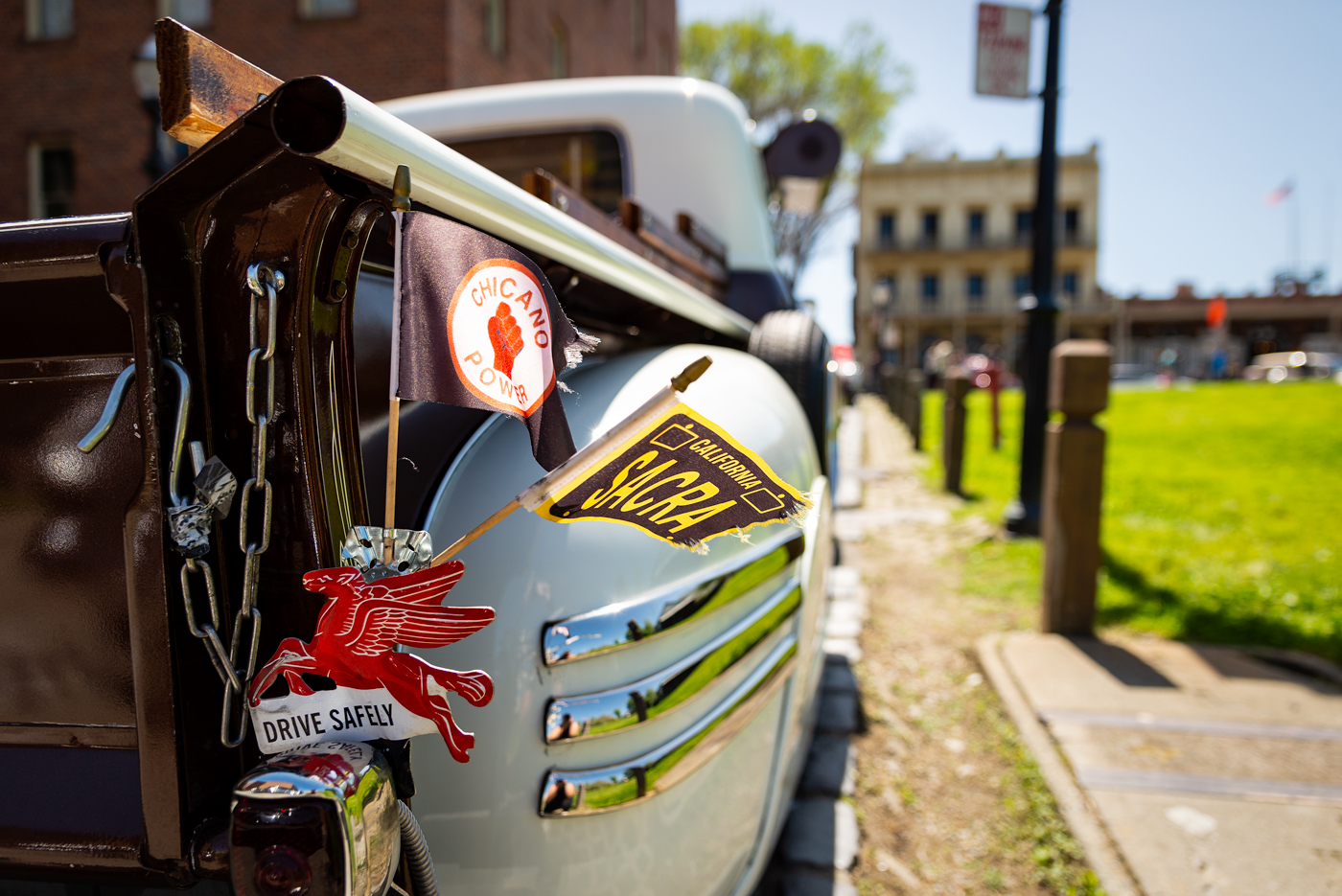
Rascal Jinzo's 1950 Chevrolet Stepside (Chevrolet 3100) "Chicano Power" fender flag
"You even see them on commercials nowadays. Where before you saw it on a movie, and the lowrider guy is shooting out the window at somebody, killing somebody," Daniel Galvez, longtime lowrider and custom painter, says.
Carlos Rodriguez, member of Dukes Car Club in Sacramento, gives a brief history of one version of the origin of lowriding.
He believes lowriding — at least originally — is deeply tied to Chicano culture and politics. Now, the demographic of lowriders has greatly expanded. All races and ethnicities participate.
"Some people think it started with the zoot suiters, the pachucos; they started dressing their own way, talking their own way, driving cars their own way."
The pachucos rejected an Anglo world. These flashy zoot suits and slang were the beginning of Mexican-American youth claiming space, symbolically.
The expression to establish identity, claim space, is the lowrider, says Félix Gutiérrez, University of Southern California professor emeritus of journalism and American and ethnic studies.
"I've been impressed by what they can do with their cars that are not in the rulebook, whether they're hopping up and down or getting low enough so you can't get a pack of cigarettes under them," Gutiérrrez says. "I see it as a positive reflection of people who want to establish their own identity on their own terms and the expression they've used is their cars."
Hear it from Gutiérrez

In the beginning, lowriding was not the high-priced lifestyle or hobby that it is now. The socio-economic situations and occupations now are diverse too. Rodriguez cited his club's past and present membership, which ranges from cops and military, to construction workers and electricians.
Galvez has a similar opinion. When he was lowriding in the 1970s to 1990s, the demographic was mostly Latino and black.
"You can't say lowriding belongs to one race. That's like saying motorcycles belong to one race. Everyone lowrides now; black, white, Asian, Latino."
The vibrant paint jobs lowriders are known to have nowadays were not always the style. Religious iconography, cultural and ethnic symbolism, and family members adorned lowriders, too.
Today's lowriding might not be about political statements, cultural pride or other original lowriding-related issue. For some it's about cruising, lowrider lifestyle and spending time with the community. Either way, though, lowriders today are committed to preserving a subculture and tradition that has been around since the 1940s.
Costs of lowriding
Building a lowrider is not cheap. Many considerations must be made. Options include lowering a classic car to building a custom car from the ground up. The basics though, no matter what style or kind of lowrider, are restoring the body and paint, suspension system and wheels.
Just the body:
Each frame of a classic car is worth a different amount too. Galvez says a 1963 Chevrolet Impala shell — no mechanical parts, interiors, anything — in paint-ready condition is worth $10,000. He can't leave it outside overnight.
But when referring to an old mini-truck, "I can leave that outside, no one wants to steal that."
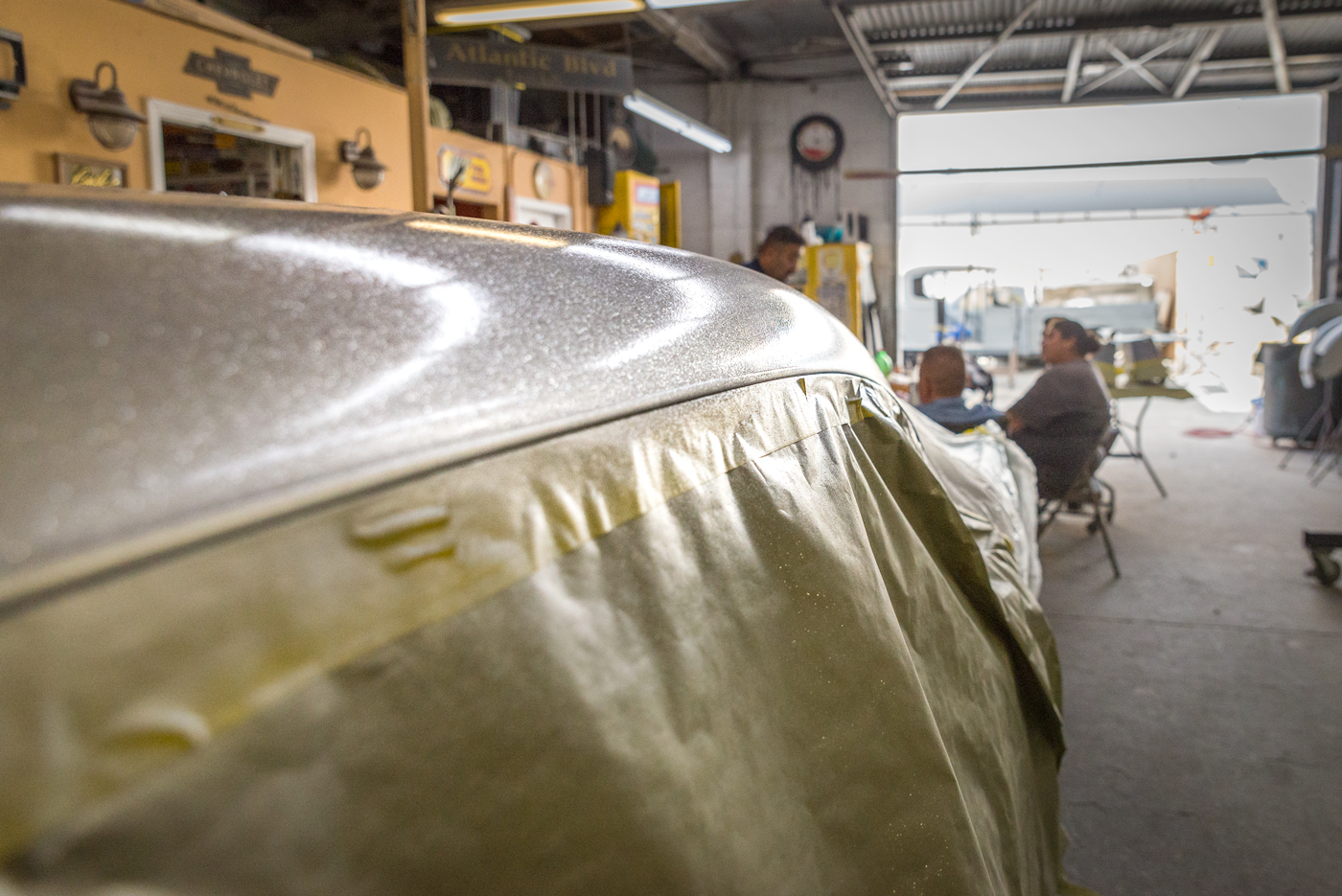
This is silver flake. Galvez, Murga and other employees stopped work to grill hot dogs lunch on this Saturday.
"If you have taste you'll get a '58 or '59 Impala," gesturing to a car in the shop. "Just the body, rough [condition], you're probably looking at $25,000."
Galvez shakes his head and says a person can easily spend $125,000 to $150,000 on a lowrider.
"Each person will spend what they can afford. Some of us can afford $125,000; some of us can afford just $15,000. You can give someone the same car and the same amount of money to fix it and it will come out totally different — and that comes down to taste."
Materials vary in costs, too. Just like cars, they are priced on a sliding scale. Red and pink paints are the most expensive because it is more labor intensive to crush the pigments. And of course, the quality of paint varies from lower-end of a couple-hundred dollars per gallon to thousands of dollars per gallon of paint.
There are candy paints, flake, gold and silver-leaf, pinstriping, graphics and other textural elements that can be layered on a car — and clear coats to seal them in between steps.
Lowriders are not like commercial cars that get two coats of paint and are out the door. Some lowriders can easily have five gallons of clear coat.
Other basic materials needed are miles of tape and paper — and of course labor. All of this adds up to the cost of a paint job. That can range from $15,000 to $100,000 and up.
Other necessities:
The remaining considerations include interior accessories and upholstery, wheels, tires and suspension. For example, the average wire or spoke wheel costs between $500 and $1,500 — and obviously a car requires four. A common tire choice is a white wall tire. These have a white band around the wheel on the exposed side and come in varying widths averaging $150 to $500 per tire.
Suspension systems and engine repairs or upgrades are in the thousands of dollars, but the requirement is to lower the vehicle. Rodriguez's bomb has springs, which he clamped down. Other people have cut theirs, added hydraulics — to quickly raise and lower their vehicle, and now enable various hopping abilities — or airbags which lower and raise the vehicle in a slower movement.
The upshot is that lowriding is customizable to each person's taste and the sky is the limit.
Original illustration for 'Photographing "Slow and Low"' by Rachel Yedam Kim @rachelyedam
Bombs and other lowriding styles:
Lowriding is not just one type of car, and sometimes not even a car. There are niche modes of transportation or building lowrider-style objects, like push cars for toddlers. In the earlier days of lowriding people started lowriding bicycles too. A large faction of lowriding is lowrider motorcycles. However, because this project is on lowrider cars, the type of vehicle under the umbrella of lowrider cars that is important to mention is a "bomb."
A bomb is any car manufactured during the World War years, up to the mid-1950s. The most obvious difference between a regular lowrider and a bomb-style lowrider is the body style. In the late 1950s and early 1960s, vehicle manufacturers drastically changed the body from big, rounded to rectangular bodies with angles.
Lowriding community voices
A woman in a man's world
Stef pinstripes with the best in an industry where back in the day — as Galvez says it — "guys drove the cars and girls were the trophies"

Murga retouches flake with candy, a tinted translucent, paint that was exposed by a buffing or sanding process. "It's like glitter for cars," she says.
Stefanie Lizet Murga works at Danny D Studios. She started three years ago as an apprentice and has no plans to leave Galvez's shop any time soon.
"My favorite thing is doing tag team striping and stuff with Danny. Like you got this side [of the car], and I got this one," she says. "It's cool because he trusts me to match the side he's doing."
As one of two full-time employees, Murga is at the shop six days a week with Galvez. Danny D Studios has weekend employees, contractors and apprentices, too.
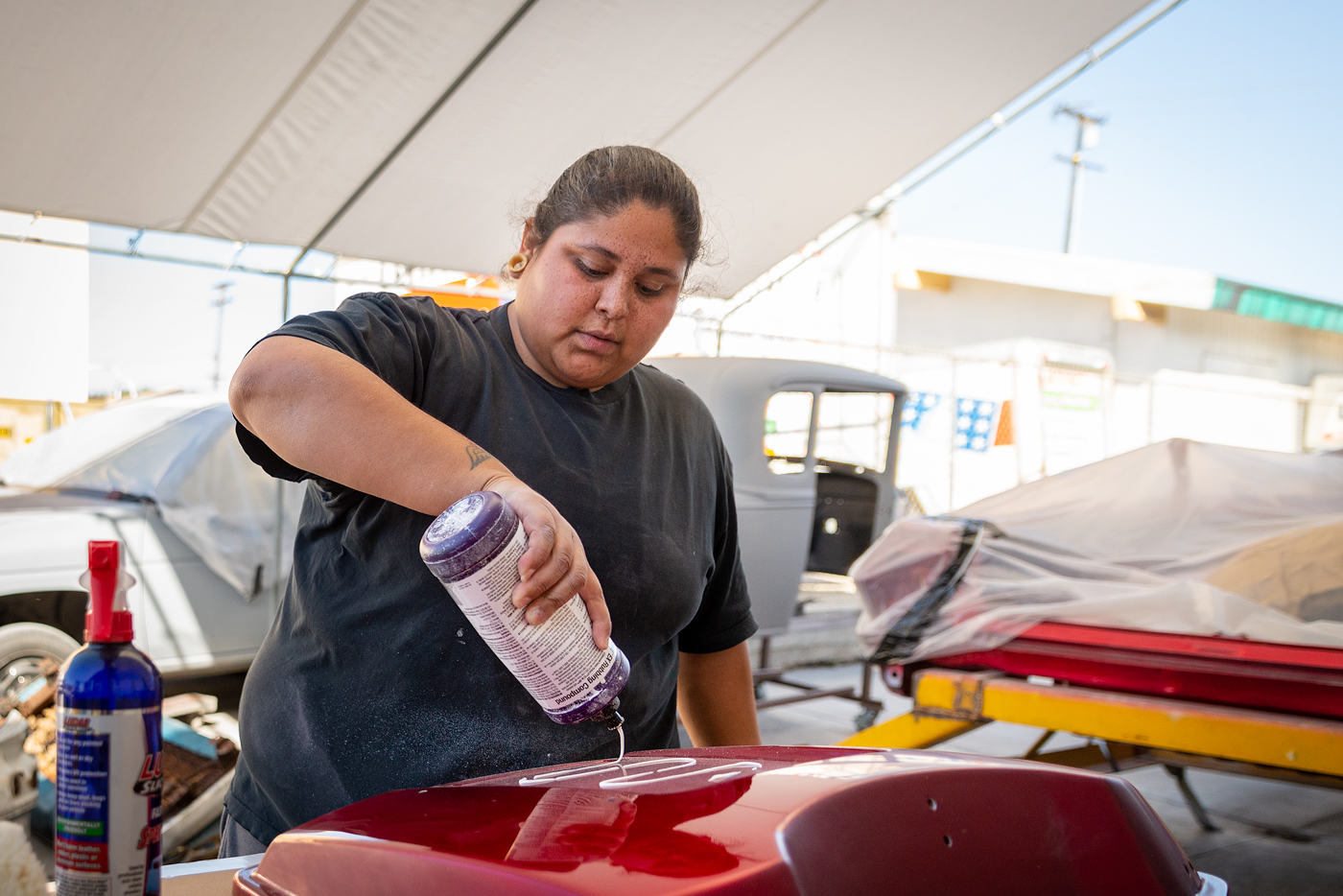
Murga, known as Stef, sands a motorcycle trunk lid. Danny D Studios is repairing and matching paint on the entire bike.
Murga says she looks after Galvez and makes sure he doesn't work too hard. She says he's enthusiastic about projects and overworks and overcommits himself.
"It's fun to see him get all excited like a little kid. Like that dragster? He busted that shit out, like damn," Murga laughs. "I just turned around and damn, that shit was done."
Murga's laugh is loud and contagious. The shop always has a levity about it — each time someone bends over Murga imitates flatulence. There is quite a bit of joking too and Murga hangs with the guys, sometimes outdoing them.
Aside from being good at shop banter, Murga is a talented artist. She was one of two women of 50 artists invited to exhibit pinstriping and lowrider-inspired art at the Petersen Automotive Museum for "The High Art of Riding Low: Ranflas, Corazón E Inspiración," an exhibit that celebrated lowriding art, iconography and Chicano pride.
Murga's contribution was part of a collection of custom painters and pinstripers who painted everyday objects in a lowrider-style pinstriping and custom paint. She painted a toilet seat. Galvez painted roller skates.
With aspirations to be greatly recognized within the lowrider and custom industries for her own work, Murga doesn't like to advertise that she works with Galvez. She says it's really gratifying when esteemed painters approach her and tell Murga that she is talented. She aspires to paint as well as they do.
It is not lost on her that Murga is one of the few women in a sea of men who professionally customize lowrider paint jobs and body work. undefined
"I'm pretty proud of myself, knowing I can do it all myself."
For pinstriping art exhibitions or art swaps Murga makes it a point to feminize her art, whether it's painting cartoon cholas with big lips instead of cholos with mustaches or using "girly colors" like pinks and purples.
The community loves her take on lowrider art — women — who've been lowriding iconography since the beginning. Murga says some of the wives of painters greatly admire her art and are jealous they don't have one yet.
It seems that Murga is well on her way — Galvez says she's part of a new wave of lowrider and custom artists.
Following in Galvez's footsteps, she is restoring and building a mini truck at her house. Now she's straightening out the body and doing other metalwork to ensure her truck will have a good foundation.
Murga has side projects and career goals, but right now she's very much dedicated to Danny D Studios.
"I'm hoping he keeps me around for the ride, you know?" Murga says. "That's what I want, for this to become more of a partnership; not just employer, employee."
Other lowriders in the community
Flora Ramos
Oldsmobile Cutlass


Jackie Hader
Chevrolet Caprice
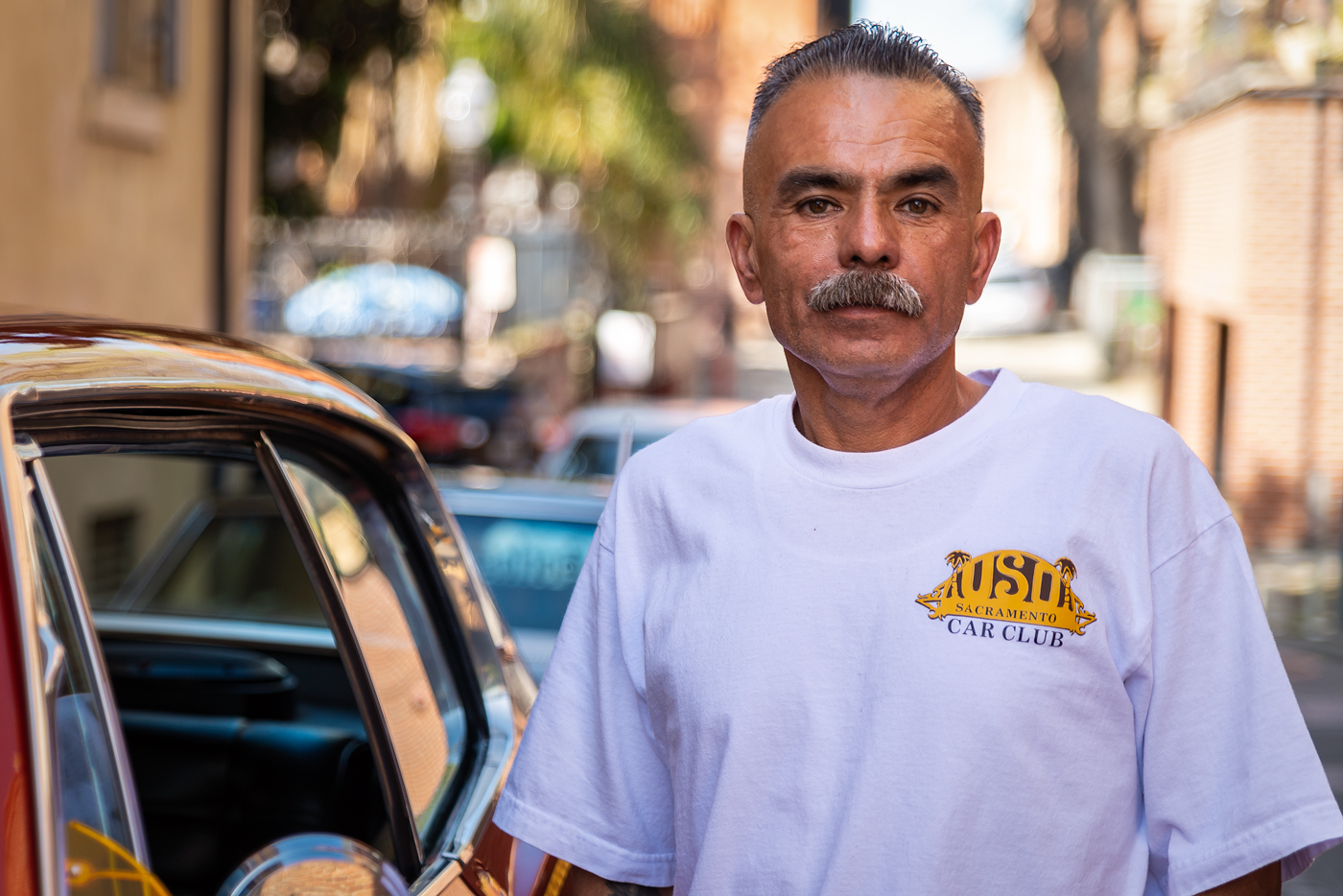

Some of the most talked about topics; a message from lowriders to the general public:
"Built not bought" is a badge of pride in the lowriding community. Scott Peebles' response, "I gave it all the love; I did all the work myself, took it all apart myself."
Rascal Jinzo's response, "Oh, yes! I built it, I didn't buy it," shaking his head with a knowing smile.
Lowriding is a lifestyle. This lifestyle requires hard work and care to maintain beautiful cars. David Sofoya's take on it:
Why lowriders?
Reflection of the process, photography and long-form video
You know how some people drool over expensive imported sportscars? I drool over classic cars. When I was 16 years old, I tried to convince my dad to buy me all kinds of cars, including a 1960s Oldsmobile and a 1960s VW bus.
For the last five to 10 years I've tried to figure out how I can get myself a lowrider.
It's almost a joke between my friends and family — to yell, "Lowrider!" as we drive down the street — because I'll whip around trying to figure out which direction they're pointing.
Lowriding is such a large part of Southern California culture. I saw plenty of them while growing up in Los Angeles County.
When it was time to pitch a semester-long project, I wanted a break from the serious issues that dominated my journalism for much of the past year — stories about bipolar disorder, mental health resources and L.A. County jails. I even took on white privilege in a photo essay featuring multiracial millennials and white privilege. With all that behind me, I was ready for a highly visual project where I could do photography and videography.
Lowriders came to mind as a cultural obsession that I wanted to explore. I was fascinated with the cars and even more fascinated with the people.
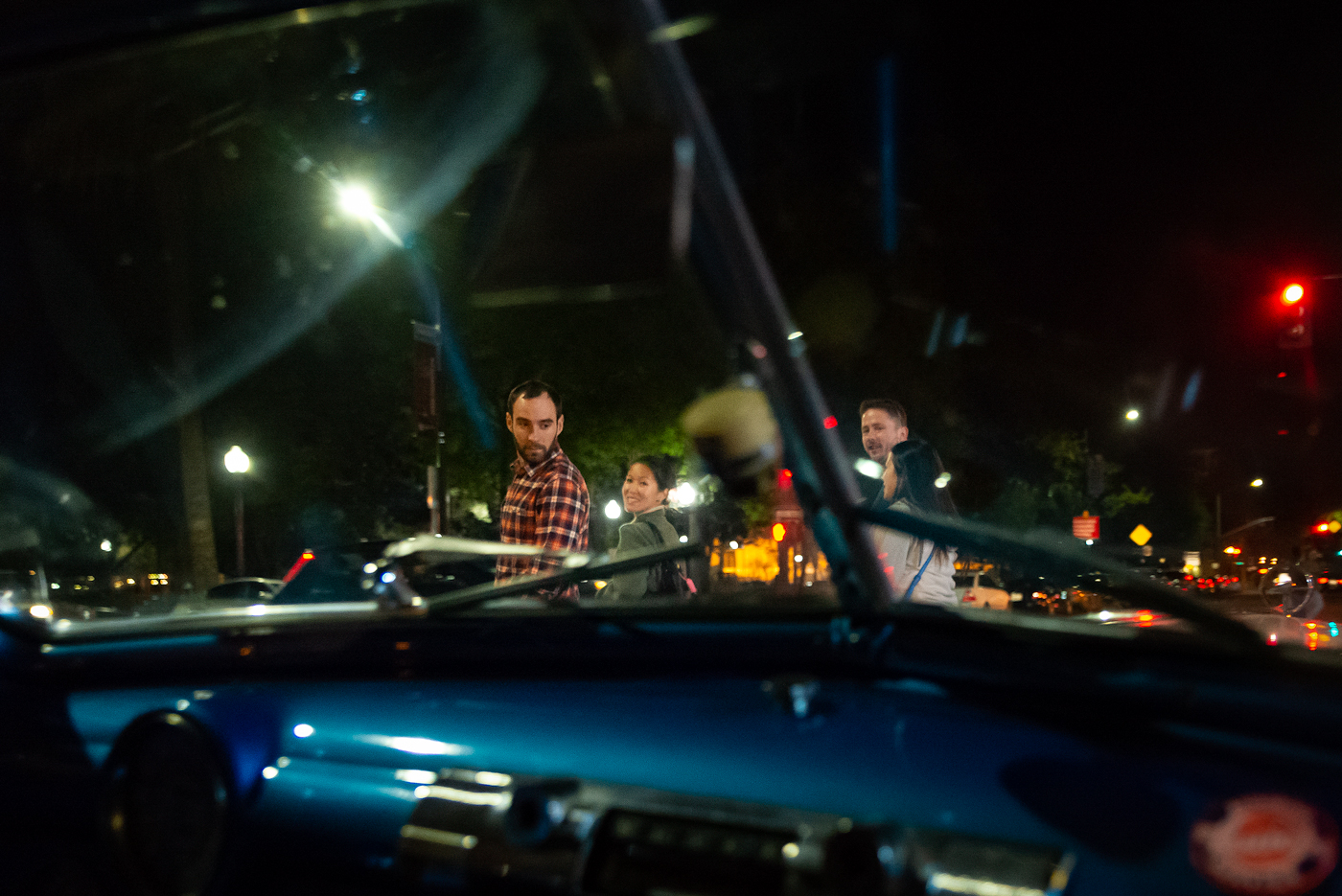
Rodriguez's 1947 Buick Super draws eyes cruising downtown Sacramento, Old Sacramento and throughout his suburban community, Rio Linda.
I learned about the obstacles they overcame. I studied the details of the decorations and the ingenuity of the engineering. I cruised in a lowrider and saw admiring fans; I hopped — bounced in a lowrider and saw crowds wowed. The portraits of these lowriders show a community full of creativity and energy.
Did you know hydraulics were fitted to cars to circumvent anti-lowriding laws and raise the car quickly when the police came around to harass those cruising low and slow? Or that the hydraulics systems were originally the hydraulics from airplanes? Alas, such facts didn't make it into my 15-minute documentary.
I am not part of the lowriding community, so seeking out lowriders and others in the community was tough for me.
As a photographer, I am comfortable behind the camera and witnessing the action. I am uncomfortable disrupting scenes and seeking out subjects. My undergraduate education in photojournalism rarely made me cultivate sources. Making a documentary was just as much a lesson in learning more aggressive reporting as it was doing the visual side of journalism.
But after asking around I struck gold with Carlos Rodriguez. He and his family were so generous with their time and personal stories. Stefanie Lizet Murga put her contact information on social media and responded to my text the same day, agreeing to meet with me. She nonchalantly mentioned her boss was a famous artist who has been lowriding since he was a kid. I finally had the characters I needed.
Different media and different experiences
As a first-time documentarian, the experience was rough. I dealt with my share of equipment malfunctions and cancellations because of weather — lowriders don't cruise in the rain.
If I were to compare the effectiveness of long-form video to photography in telling a story, I'd choose photography.
It's easier to tell a story with context and more details in video but even the most powerful scenes pass quickly before seemingly vanishing forever. In photography, the nuances of emotion and relationships between people and their world are frozen and distinguishable. Images are iconic. They define moments in history. A single image resonates more with people than 24 frames per second.
A titan of photojournalism, Henri Cartier-Bresson, calls the moment when the photographer knows the instant to make a photograph — when the composition is correct and action is at its peak — "the decisive moment."
I plan to produce more documentaries. They are a popular way of conveying important information and build on my photojournalism skills. But I prefer to study human existence through a closer lens, one frame at a time.

































